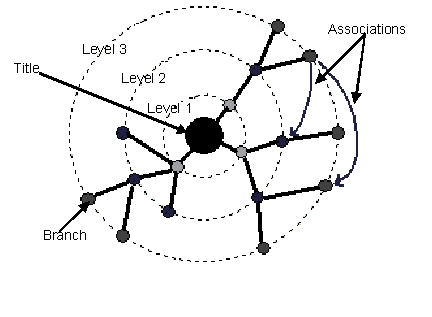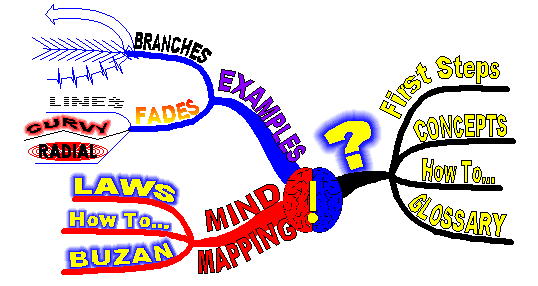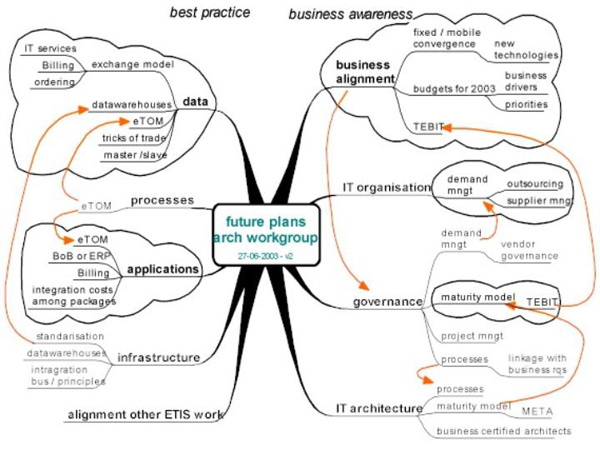A Mind Map is a powerful graphic technique which provides a universal
key to unlock the potential of the brain. It harnesses the full range
of cortical skills – word, image, number, logic, rhythm, colour
and spatial awareness – in a single, uniquely powerful manner.
In so doing, it gives you the freedom to roam the infinite expanses
of your brain. Mind Maps can be applied to every aspect of life where
improved learning and clearer thinking will enhance human performance.
Developed by English psychologist Tony Buzan in 1960, Mind Maps were
first presented as a new method for note-taking and brainstorming. By
using Mind Maps you show the structure of the subject and linkages between
points, as well as the raw facts contained in normal notes. Mind Maps
hold information in a format that your mind will find easy to remember
and quick to review. In fact, they abandon the list format of conventional
note taking., doing this in favor of a two-dimensional structure. A
good Mind Map shows the 'shape' of the subject, the relative importance
of individual points and the way in which one fact relates to other.
Mind Maps are more compact than conventional notes, often taking up
one side of paper. This helps you to make associations easily. If you
find out more information after you have drawn the main Mind Map, then
you can easily integrate it with little disruption.
This technique was proposed to the scientific community as a tool for
representing knowledge, using both logic and creativity. Buzan’s
studies started from two fundamental assumptions:
- Human mind can associate concepts and information in a non-linear way: the linear paradigm, which considers a logical path between the starting point and the conclusions, prevents the possibility to create effective associations. To this paradigm Mind Maps opposes a dynamic structure with a centre but without an end.
- The brain is composed by two different functional parts: left part of the brain processes information in a linear, logical, analytical, rational way. It could be stimulated by textual or verbal representation. On the contrary, right part of the brain works in non-linear, holistic, intuitive, non-verbal way (see Lateral Thinking). It is stimulated by hierarchical representations, symbols and images.
Mind mapping approach is a technique that aims to balance both these
two aspects of human’s nature: rationality and feeling. Indeed,
unlike a computer, human brain works not only in linear way but also
in associative manner. In fact, on one hand we are able to make comparisons,
to integrate or to synthetize information. On the other hand, associations
are fundamental in nearly all our mental functions. Indeed every word
and each idea relates to a lot of other concepts. It seems as all collected
information are subsequently organized in an interconnected net. In
this sense, Mind Maps are a tool for keeping note about ideas linkages,
helping individuals to generate new ideas thanks to associative thinking.
Mind Maps are also very quick to review, as it is easy to refresh information
in your mind just by glancing at one. They can also be effective mnemonics.
Remembering the shape and structure of a Mind Map can provide the cues
necessary to remember the information within it. They engage much more
of the brain in the process of assimilating and connecting facts than
conventional notes.
Building a mind map
A mind map is composed by two elements: concepts and relations between them. As Buzan says (1989):
“… a mind map starts from a word (or principal idea); this central word is associated with 5-10 other principal ideas, related with this first one. Again, each of this words is associated to other 5-10 principal words related with everyone of this terms, and so on.”
Therefore a mind map is a diagram in which concepts are graphically represented according to a radial structure. A complete Mind Map may have main topic lines radiating in all directions from the center. Sub-topics and facts will branch off these, like branches and twigs from the trunk of a tree. You do not need to worry about the structure produced, as this will evolve of its own accord. The map provides an effective overall vision which helps individuals to process thoughts and ideas, starting from pre-existent elements.
As affirmed by Buzan (1989), radial structure has many positive aspects:
- the main idea is immediately perceived;
- the significance of each idea is clearly understood, because more
important ones are located near the core concept while the less important
ideas are far from it;
- the nature of the structure allows the mind to create new linkages.
Thanks to the great quantity of possible associations, mind mapping
approach is a very creative process and provides the opportunity to
generate new ideas and associations previously unexpected.
Moreover, a linear presentation such as a list neutralizes creativity
because of its static structure pervaded with a “beginning”
and an “end”. The latter inhibits the brain from making
new associations while, on the contrary, the dynamic structure of a
mind map supports better idea generation process.
At this point, it is clear that the most important characteristics of
the mind mapping approach are the emphasis on:
- hierarchical-associative informational structure;
- large use of perceptive elements as colours and images, which stimulate the creativity of the map-maker and the curiosity of the reader.
In this sense it is possible to affirm that Mind Maps help individuals to organize their ideas, to find key-words, to develop associations between different ideas and the relationship between similar ideas. They stimulates their visual memory using colours, symbols, icons, arrows, text highlights.
Effectiveness of a Mind Map
The effectiveness of a mind map depends mostly on the quality of graphic representation. Therefore elements of the map should be opportunely chosen. Indeed each element should evoke new ideas or new concepts to link up. For this reason, it is important to use some clever devices, as for example to:
- use single words or simple phrases for information. Most words in
normal writing are padding, as they ensure that facts are conveyed
in the correct context, and in a format that is pleasant to read.
Single strong words and meaningful phrases can convey the same meaning
more potently. Excess words just clutter the Mind Map.
- start with a painted image put in the centre of the sheet. This
image represents the main concept of the scheme;
- use key-words in each branch, while the branch’s dimension
should be proportioned to the context’s significance;
- use evocative images to have more impact on the reader;
- put different concepts on different branches in order to allow future
changes on the map;
- use colours to separate different ideas in order to be able to distinguish
them;
- use colours for branches and terms, because this colours stimulate
creativity and memorization;
- use cross-linkage. Information in one part of the Mind Map may relate to another part. Here it is possible to draw in lines to show the cross-linkages. This helps to see how one part of the subject affects another.
According to this simple rules everyone will be able to:
- let the ideas spring out freely and quickly;
- produce maps that are closer with his/her own way of thinking.
Reading a Mind Map
The power of a mind map refers to its possibility to combine information using different expressive tools, as graphics, colours, icons and so on. Mind maps uses hierarchical-associative structure that allows the author to insert and classify data, but also to visualize the links between them. In particular, it is possible to represent generalization/particularization processes applied to concepts, activities data etc.
There are different ways to interpret a mind map, according to five main reading keys:
- from centre to periphery, the map gives information with growing
detail;
- from periphery to centre, the map gives information with growing
generalization;
- in a single part of it, the map allows to focus on a particular
content;
- as a whole, the map gives an overall point of view of the related
topic;
- in the associative links, the map allows readers to find out relations
not previously related to any hierarchical linkage.

Source:mind-map.com
Conclusions
The Mind Mapping technique is useful to organize and
to communicate ideas, to organize information, to find out key-words,
to develop associations between different ideas and to develop relations
between similar ideas, to stimulate visual memory using colours, symbols,
icons, arrows, etc. Starting from a core concept, this technique develops
it in many different ways.
The maps supports representation and creativity because they let the
reader have an overall point of view of the topic by a single look.
Examples of Mind Maps
In this section there are some examples of Mind Maps. As you may see, this technique may be applied to every kind of problem.
Example 1: Mind Map’s Map

Source: www.bignell.de
Example 2: Mind Map of an organization

Source: www.etis.org/activities/itarchim4.jpg
-
Buzan T. Use Your Head, BBC Consumer Publishing, London,1989.
-
Buzan T., Use Both Sides of your Brain, Plume, 1989.
-
Buzan T., The Mind Map Book – How to Use Radiant Thinking to Maximize Your Brain’s Untapped Potential, Plume, 2003.
-
Jaoui H., Creativity: How to Use It, Paris, ESF éditeur-Enterprise Moderne d’Edition et Libraires Techniques, 1990.
Original title: Jaoui H., La creativitè mode d’emploi, Paris, ESF éditeur-Enterprise Moderne d’Edition et Libraires Techniques, 1990. -
Vicari S., Enterprise’s Creativity between Chanche and Reality, Milan, Etas Libri, 1998. Original title: Vicari S., La creatività dell’impresa. Tra caso e realtà, Milano, Etas Libri, 1998.